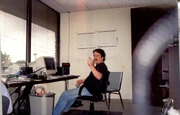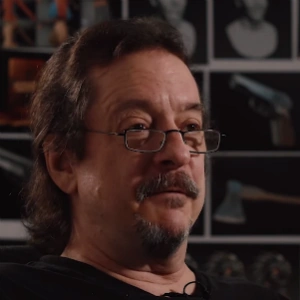Richard "Levelord" Gray
Tag: Visual edit
Tag: Visual edit
Line 15: Line 15:There is no clear evidence of Gray's contributions in the [[Duke Nukem 3D prototypes#May 1995|May 1995 prototypes]]. [[Warp Factor]], a map for which Gray is credited as the sole designer in the final game, appeared in the May 1995 prototypes, but there are several reasons to doubt that this iteration was designed by Gray. It is known from the 20th anniversary developer commentary and [[sector chronology]] that the map was started by Allen Blum (''see [[L7]] for more information''). In addition, almost everything from this version of the map would be scrapped and later repurposed on [[It's Impossible]]. The fact that the materials were repurposed on It's Impossible is a strong indication that they were not scrapped because the team did not like them but for some other reason; most likely, it is because the map was reassigned to Gray, who wanted to make the map his own.
There is no clear evidence of Gray's contributions in the [[Duke Nukem 3D prototypes#May 1995|May 1995 prototypes]]. [[Warp Factor]], a map for which Gray is credited as the sole designer in the final game, appeared in the May 1995 prototypes, but there are several reasons to doubt that this iteration was designed by Gray. It is known from the 20th anniversary developer commentary and [[sector chronology]] that the map was started by Allen Blum (''see [[L7]] for more information''). In addition, almost everything from this version of the map would be scrapped and later repurposed on [[It's Impossible]]. The fact that the materials were repurposed on It's Impossible is a strong indication that they were not scrapped because the team did not like them but for some other reason; most likely, it is because the map was reassigned to Gray, who wanted to make the map his own.
−However, Gray could not have joined later than October 1995. Screenshots of an area that would become the exterior of Gray's [[Sweeney]] appear in a batch of photos released by 3D Realms in August 1995 (see [[:File:95-15Aug11-07.PNG|here]]), but it is disputed whether this area began development on Sweeney itself or was copied from a later iteration of [[O1]] by Blum. The first undisputed screenshots of Gray's work (see [[:File:95-18AugOct-03.png|here]] and [[:File:95-18AugOct-04.png|here]]) show a HUD that can be narrowly dated to early October 1995.
+However, Gray could not have joined later than October 1995. Screenshots of an area that would become the exterior of Gray's [[Sweeney]] appear in a batch of photos released by 3D Realms in August 1995 (see [[:File:95-15Aug11-07.PNG|here]]), but it is disputed whether this area began development on Sweeney itself or was copied from a later iteration of [[O1]] by Blum (''see [[O1]] for more information''). The first undisputed screenshots of Gray's work (see [[:File:95-18AugOct-03.png|here]] and [[:File:95-18AugOct-04.png|here]]) show a HUD that can be narrowly dated to early October 1995.
[[Shrapnel City]] was Gray's largest contribution to the game. Except for the boss map and one of the secret maps, all levels in the episode were designed by Gray.{{clear}}
[[Shrapnel City]] was Gray's largest contribution to the game. Except for the boss map and one of the secret maps, all levels in the episode were designed by Gray.{{clear}}
Richard Bailey Gray, better known as Levelord, is a video game developer who is famous for designing the levels in video games such as Duke Nukem 3D, Quake, and SiN. Gray co-founded Ritual Entertainment in 1996 and later founded Let It Rain Games in 2009. Since 2019, Gray has been working with Mundfish, the developers of Atomic Heart.
Impressed by his user-made Doom maps in the early 1990s, QStudios hired Gray to work on Blood in September 1994. Blood was being developed in Build, the same game engine used by Duke Nukem 3D, and the project was being funded by publisher Apogee Software.
Through QStudios' relationship with Apogee Software, Gray was introduced to George Broussard, who was a project lead on Duke Nukem 3D. Broussard poached Gray from QStudios and convinced him to move from the West Coast to Garland, Texas, where 3D Realms (formerly "Apogee Software") was headquartered. This move was later cited as a cause of tension with QStudios and may explain why Blood was ultimately published through GT Interactive rather than 3D Realms.

Gray in March 1995
It is not known precisely when Gray joined the Duke Nukem 3D team. It is particularly difficult to estimate his start date because many of Gray's maps were started by Allen Blum. However, Gray's earliest undisputed contributions can be dated to October 1995.
As explained in the 20th anniversary developer commentary, Gray joined the team sometime after the completion of the December 1994 prototype and during a period when Allen Blum was working on levels in Lunar Apocalypse. Beta screenshots from Lunar Apocalypse span the entirety of 1995, with new maps like Lunar Reactor not appearing until as late as August, so it is unclear from Gray's statements when he joined the team, except that he joined sometime in 1995.
There is no clear evidence of Gray's contributions in the May 1995 prototypes. Warp Factor, a map for which Gray is credited as the sole designer in the final game, appeared in the May 1995 prototypes, but there are several reasons to doubt that this iteration was designed by Gray. It is known from the 20th anniversary developer commentary and sector chronology that the map was started by Allen Blum (see L7 for more information). In addition, almost everything from this version of the map would be scrapped and later repurposed on It's Impossible. The fact that the materials were repurposed on It's Impossible is a strong indication that they were not scrapped because the team did not like them but for some other reason; most likely, it is because the map was reassigned to Gray, who wanted to make the map his own.
However, Gray could not have joined later than October 1995. Screenshots of an area that would become the exterior of Gray's Sweeney appear in a batch of photos released by 3D Realms in August 1995 (see here), but it is disputed whether this area began development on Sweeney itself or was copied from a later iteration of O1 by Blum (see O1 for more information). The first undisputed screenshots of Gray's work (see here and here) show a HUD that can be narrowly dated to early October 1995.
Shrapnel City was Gray's largest contribution to the game. Except for the boss map and one of the secret maps, all levels in the episode were designed by Gray.

Gray at 3D Realms
After the April 1996 publication of Duke Nukem 3D, Gray continued working on new levels for Duke Nukem 3D: Atomic Edition.
Gray left 3D Realms no later than August 1996, when the video game studio he co-founded, Ritual Entertainment, first opened. In fact, Gray says in the 20th anniversary developer commentary that he left before Pitchford joined the team, suggesting his departure may have been significantly earlier than August. For this reason, he never saw the completion of the Atomic Edition.
In the years that followed, it became a matter of public dispute to what extent Gray deserved credit for levels in the The Birth, a new episode introduced as part of the Atomic Edition. Despite several levels being credited to other developers, Gray publicly took credit for doing the bulk of the work on some of these, including Shop-N-Bag, Pigsty, and XXX-Stacy. Gray even stated that Pigsty was his favorite creation and that the level was "99.44%" his work. Because his signature appears on Critical Mass, Gray likely made significant contributions to that level as well. However, the degree to which each of the level designers deserves credit for these levels remains controversial. (See The Birth#Disputed authorship for more information.)

Gray in Russia
In 2016, Gray was contracted by Gearbox Software to design four new levels to commemorate the 20th anniversary of Duke Nukem 3D.
Packaged as part of a fifth episode titled Alien World Order, Gray contributed Red Ruckus, Bloody Hell, Tour de Nukem, and Prima Arena to Duke Nukem 3D: 20th Anniversary World Tour. Bloody Hell, in particular, was a collaboration with Randy Pitchford.
As a fluent speaker of Russian and a resident of Moscow, Gray wrote jokes in Russian on all the signs and posters on Red Ruckus, and he included many Easter eggs that are only recognizable to his family and friends back home.
Gray also contributed commentary to every single level of the game that featured commentary as part of the 20th anniversary developer commentary.

Gray in the early 2000s
Gray is widely loved by members of the online Duke Nukem community. He is particularly well-known for several aspects of his approach to level design and his interaction with the playerbase.
Sometime in the late 90s or early 2000s, Gray took notice of the highly active online community of amateur level designers, who had several websites devoted to sharing user maps and total conversions for Duke Nukem 3D. Gray decided to share four of his own maps that were scrapped before the 1996 release of Duke Nukem 3D: Sweeney, Sewer, Chuckles, and Cigam. In the information provided with the maps, Gray identified himself as "Levelord(TM)" and stated that his maps "can be altered by any and all Levelserfs."
In the 20th anniversary developer commentary, it was revealed that Gray intermittently follows the Duke Nukem 3D speedrunning community, and Gray was aware of a speedrunning route on Hollywood Holocaust that his follow developers did not seem to know.
Easter eggs and hidden messages appear frequently in Gray's work. Some of these Easter eggs can only be found by viewing the level in an editor program or by cheating in the game; such Easter eggs often feature messages such as "You're not supposed to be here!" His hidden messages are always signed using his alias, "Levelord."
Gray typically signs his maps with the letters "SUYT" (an acronym for "show us your tits") somewhere on the level, usually out of bounds.
Gray also is known for designing multiplayer maps and then repurposing them as secret levels for inclusion in the singleplayer campaign. These maps include Lunatic Fringe, Spin Cycle, Tier Drops, and Prima Arena.









